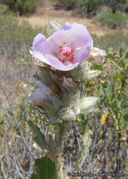Taxon Report
Malacothamnus marrubioides (Durand & Hilg.) GreeneSanta Clarita bushmallow |
 © 2016 Keir Morse |
Taxon Summary
Malacothamnus marrubioides, commonly known as Santa Clarita bushmallow, is a perennial deciduous shrub in the Malvaceae that is found only in California. It occurs within Chaparral, Cismontane woodland, and Riparian woodland, growing at elevations from 55 to 1170 meters. Malacothamnus marrubioides is ranked 4.2, Plants of Limited Distribution, A Watch List; Moderately threatened in California.Classification
|
Scientific Name: |
Malacothamnus marrubioides (Durand & Hilg.) Greene |
|
Common Name: |
Santa Clarita bushmallow |
| Family: | Malvaceae |
| Element Code: | PDMAL0Q0A0 |
| USDA Plants Symbol: | MAMA3 |
|
Synonyms/Other Names: |
|
Ecology and Life History
| Lifeform: | perennial deciduous shrub |
| Blooming Period: (Jan-Mar)Apr-Jul(Aug-Dec) | (Jan-Mar)Apr-Jul(Aug-Dec) |
| Elevation: | 55-1170 (180-3840) |
| General Habitats: | Chaparral, Cismontane woodland, Riparian woodland |
| Microhabitat: | |
| Microhabitat Details: | Fire-adapted; populations usually peak after burning occurs. |
Conservation Status
| CA Rare Plant Rank: | 4.2 |
| Global Rank: | G3? |
|
State Rank: |
S3 |
| State List: | None |
| Fed List: | None |
| Other Status: | |
|
CRPR Changes: |
|
Occurrence Data from the CNDDB
| Total Occurrences: | 0 |
| Element Occurrence Ranks: | |
| Excellent (A) | 0 |
| Good (B) | 0 |
| Fair (C) | 0 |
| Poor (D) | 0 |
| None (X) | 0 |
| Unknown (U) | 0 |
| California Endemic: True | |
| California Counties and Islands: Name (Code) | |
| Ventura (VEN) | |
| Quads: Name (Quad Code) | |
| Acton (3411842), Agua Dulce (3411843), Black Mtn. (3411867), Cobblestone Mtn. (3411857), Green Valley (3411854), Liebre Mtn. (3411866), Mint Canyon (3411844), Moorpark (3411838), Newhall (3411845), Pacifico Mountain (3411841), San Fernando (3411834), Santa Paula (3411931), Val Verde (3411846), Warm Springs Mountain (3411855), Whitaker Peak (3411856) | |
Threat List Data from the CNDDB
| Threat List Total: | 0 | |
| EOs with Threat Listed: | Total EOs | % of EOs |
| 0 | 0 % | |
Notes
| Most similar to the inland form of M. foliosus, which is allopatric. Intermediates with M. fasciculatus var. laxiflorus and M. orbiculatus are common where their ranges meet M. marrubioides. |
|
Threats: |
| Threatened by development and hybridization. Potentially threatened by altered fire regimes and competition from non-native plants. |
|
Taxonomy: |
| See Leaflets of Botanical Observation and Criticism 1(15): 208 (1906) for original description. |
Selected References
| CNPS Status Review: Proposed addition to CRPR 4.2, G3 / S3 (2025) |
| Malacothamnus 3 (2023) |
| Malacothamnus 3 (2023) |
Citation
California Native Plant Society, Rare Plant Program. 2025. Rare Plant Inventory (online edition, v9.5.1). Website https://www.rareplants.cnps.org [accessed 26 December 2025].